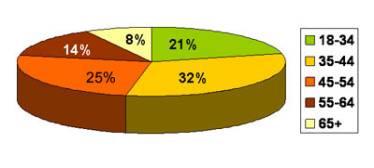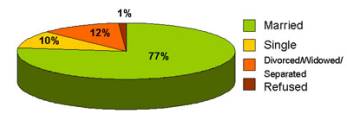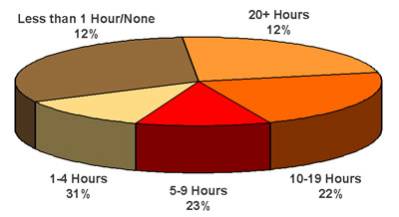Benefits of Direct Selling
Research shows some of the most popular reasons people choose direct selling are:
- Direct selling is a good way to meet and socialize with people.
- Direct selling offers flexible work schedules.
- Direct selling is a good way to earn extra income.
- Direct selling is a good way to own a business.
- Earnings are in proportion to efforts.
Anyone can do it.
There are no required levels of education, experience, financial resources or physical condition.
People of all ages and from all backgrounds have succeeded in direct selling.
Direct sellers are independent contractors. You're your own boss, which means you can:
- Work part-time or full-time - you choose when and how much you want to work.
- Set your own goals and determine yourself how to reach them.
- Earn in proportion to your own efforts. The level of success you can achieve is limited only by your willingness to work hard.
- Own a business of your own with very little or no capital investment.
- Receive training and support from an established company.
People like to shop through direct selling.
According to recent surveys, 74 percent of Americans have purchased goods or services through direct sales. That's more than the number who have purchased through television shopping and on-line computer services combined. People value the products available through direct selling and 45 percent of Americans want to buy from direct sellers.
Direct selling is a growing industry.
Sales in the U.S. have more than doubled in the last decade to more than $30 billion and are now more than $100 billion worldwide.
People from literally all walks of life, of all ages, are successful in direct sales. About 75 percent of those working in direct sales are women, 10 percent are African American, six percent are Latino and three percent are Asian, Native American or other. Many people start part-time, and later leave their other careers when direct selling becomes more lucrative.
Percent of Sales by Major Product Groups

Clothing & Accessories/personal care
(cosmetics, jewelry, skin care, etc.) |
32.8% |
Home/family care/home durables
(cleaning products, cookware, cutlery, etc.) |
25.6% |
Wellness
(weight loss products, vitamins, etc.) |
21.4% |
Services/other |
16.2% |
Leisure/educational
(books, videos, toys, etc.) |
4.0% |
Back to top

Location of Sales (reported as a percent of sales dollars)

Face-to-Face Selling 77.1% |
|
|
In the home |
70.4% |
Temporary location |
3.7% |
Workplace |
2.5% |
Other locations |
0.5% |
Remote Selling 22.9% |
|
|
Internet |
11.4% |
Phone |
8.8% |
Other remote selling |
2.7% |
Back to top

Percent of Sales by Census Region

West |
26.8% |
Midwest |
23.3% |
Northeast |
18.3% |
South |
31.6% |
Back to top

Sales Strategy
(method used to generate sales, reported as a percent of sales dollars)

Individual/Person-to-Person selling |
64.5% |
Party plan/group selling |
27.7% |
Customer placing order directly with firm
(in followup to a face-to-face solicitation) |
6.6% |
Other |
1.2% |
Back to top

Compensation Structure
(multilevel vs. single level)

Percent of firms |
95.0%/5.0% |
Percent of Sales |
97.3%/2.7% |
Percent of Sellers |
98.2%/1.8% |
Back to top

Gender

Back to top

Age (from 2008 National Salesforce Survey)

Back to top

Marital Status (from 2008 National Salesforce Survey)

Back to top

Education (from 2008 National Salesforce Survey)

Back to top

Hours Spent on Direct Selling Per Week (from 2008 National Salesforce Survey)

What is Direct Selling
Direct Selling is the sale of a consumer product or service, person-to-person, away from a fixed retail location. These products and services are marketed to customers by independent salespeople. Depending on the company, the salespeople may be called distributors, representatives, consultants or various other titles. Products are sold primarily through in-home product demonstrations, parties and one-on-one selling.
DSA's 2000 Direct Selling Public Attitude Tracking Survey, conducted by Burke Marketing Research, assessed public attitudes toward the direct selling industry. This study updates the findings of an earlier DSA study conducted by Wirthlin Worldwide (1997). Data from both surveys indicate that direct selling remains a vibrant marketing method that engenders considerable loyalty among its representatives and customers. Recent marketing innovations such as use of the Internet and mall kiosks, while less prevalent than traditional direct selling approaches, are gradually increasing in importance. Some particular points of interest include:
The direct selling industry has touched a majority of adult Americans.
- The direct selling industry has touched a majority of adult Americans: In 2000, 55 percent of American adults reported having, at some time, purchased goods or services from a direct selling representative. This represents a slight increase over the Wirthlin figures.
- In the 2000 survey, one in five American adults (20%) reported they are now (6%) or have been (14%) a direct selling representative.
- Among direct selling customers, three out of four (77%) have attended an in-home demonstration or party.
The market potential for direct selling.
- Thirty-eight percent of adult Americans surveyed in 2000 have some interest in purchasing a product or service in the future via direct selling, but only 27 percent had actually made a direct selling purchase in the past year. Both figures are about the same as in the earlier survey (Wirthlin Worldwide, 1997).
- With public interest in purchasing through direct selling (38%) exceeding those who have purchased (27%), these recent figures suggest there is an opportunity for growth!
Are America's shopping patterns changing?
- As reported in 2000, the 55 percent of American adults who have ever purchased by direct selling is exceeded only by the percentage of those who have ever purchased via retail stores (96%) or through mail order catalogs (83%).
- The percentage of American adults who are somewhat, very or extremely interested in using the Internet as a method of purchasing products and services in the future has increased from the 30 percent of American adults reported in the 1997 survey to the 50 percent reported in 2000.
Q. Who is involved in direct selling?
A. An estimated 15 million people are involved in direct selling in the U.S., and more than 68 million worldwide. Most are women, though nearly a third are men or two-person teams such as couples. The vast majority are independent business people - they are micro-entrepreneurs whose purpose is to sell the product and/or services of the company they voluntarily choose to represent - not employees of the company. Approximately 90 percent of all direct sellers operate their businesses part-time.
Q. Are U.S. direct sales increasing?
A. Yes. Direct selling is a robust industry. U.S. sales totaled $30.8 billion in 2007, with more than 74 percent of the American public having purchased goods or services through direct selling. Worldwide sales are also strong with more than $112 billion in sales.
Q. What products and services are marketed through direct selling?
A. Virtually every consumer product or service can be purchased through direct selling. People who purchase through direct selling cite product quality, uniqueness and money-back guarantees as the top reasons for shopping through direct selling.
Back to top
|









